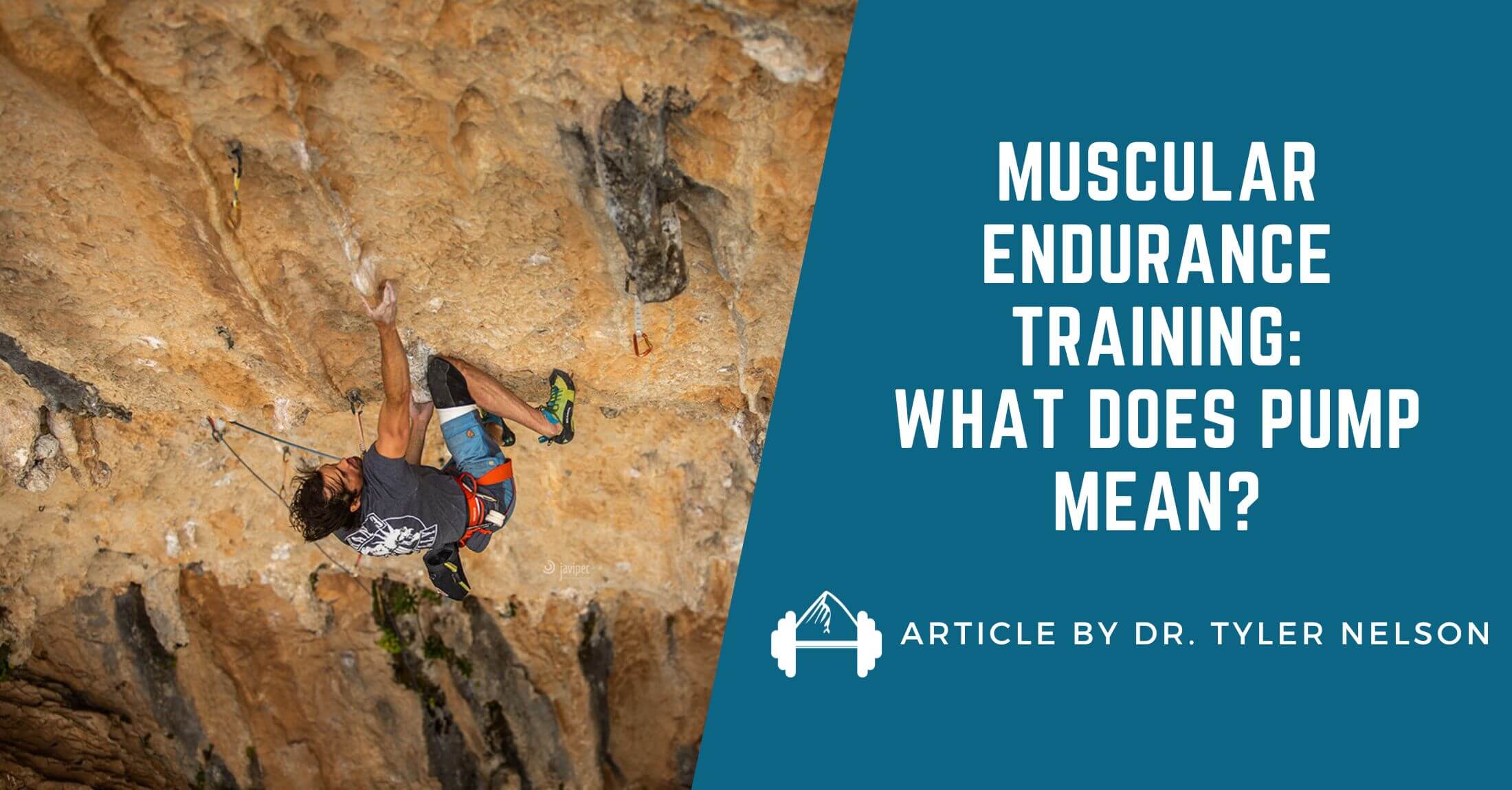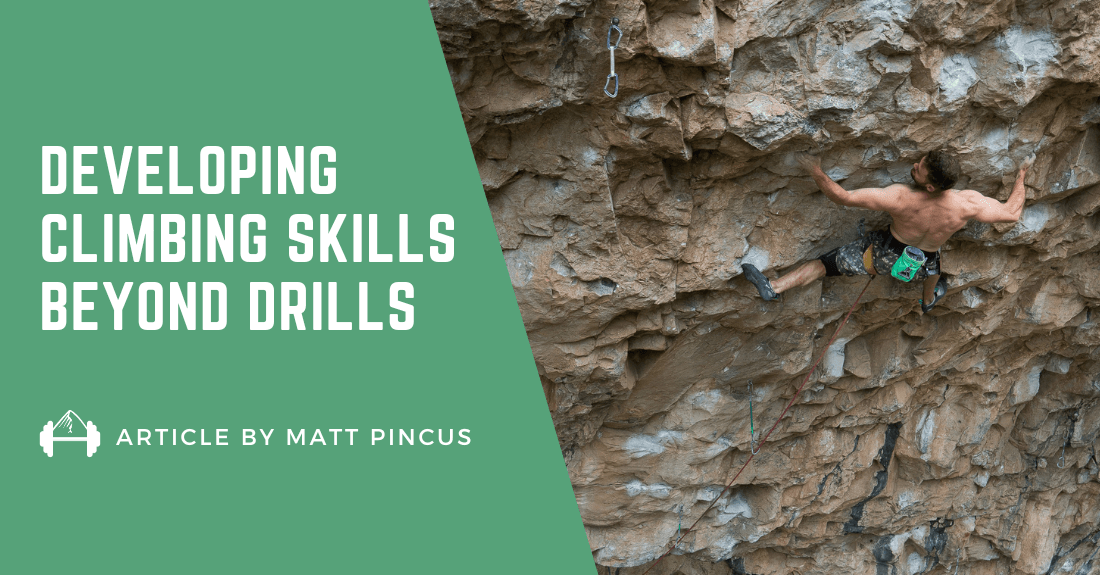This article was written by Dr. Tyler Nelson, a sports scientist and climber who owns Camp 4 Human Performance, a chiropractic sports medicine clinic and strength and conditioning business in Salt Lake City.
Work with Dr. Tyler Nelson
If you’d like to work with Dr. Tyler Nelson on an individual basis for injuries or strength training, he offers remote consultations to people all over the world. He also teaches online classes on strength training and injuries. Learn more.
To Pull or Hang? That Is the Question… for Endurance at Least.
Tyler Nelson DC, MS, CSCS
@C4HP

It is kind of confusing to know while climbing if you are pulling with your fingers, or simply hanging on your fingers and putting the load on your toes. I think it ultimately depends on the demands of the effort (more pulling with hard bouldering, crux moves etc.) but I would argue that the answer is likely somewhere in the middle. You’re not only hanging on your fingers but also pulling with them to perform harder climbing moves.
In this article, I am going to break down the physiologic difference between them (pulling and hanging) and theorize on some potential uses for each in your training.
PIMA vs HIMA
If you have read my article The Simplest Finger Training Program, you’re likely familiar with the terms overcoming versus yielding isometrics. Even so, it is worth doing a quick review here. If you have not, I would suggest checking out that article for a more in-depth discussion. An overcoming isometric is when the individual applies a force (pushing or pulling) with the intention of “overcoming” the immovable object. This isometric type is generally performed at 100% intensity and will be referred to as PIMA (Pulling or Pushing Isometric Muscle Action) in this article.
By contrast, a yielding isometric is performed at a submaximal intensity in which the individual is trying to “yield”, or hold the movement for a set duration, or to failure. These can be done at variable amounts of one’s maximum strength and will be referred to as HIMA (Holding Isometric Muscle Action) in this article.

If we compare these two types of isometrics to their dynamic counterparts (concentric and eccentric) we see that overcoming isometrics are more similar to concentric (in which the load is moved), and yielding isometrics are more similar to eccentric (in which the load is lowered due to the muscle being unable to lift it). This is an important distinction because each type of muscle work has its own “neural strategy” (motor recruitment and coordination across a joint) and energy expenditure (metabolic cost).
In addition to the physiologic differences, we also use both for sports performance. Concentric forces for pulling the fingers into position and eccentric forces are used for deceleration (contact strength). If we put a high contraction speed isometric in the middle it creates a full stretch-shortening cycle, in this example for the finger flexors. That topic, the stretch-shortening cycle, is not the topic in this article.

BMC Sports Sci Med Rehabil. 2017; 9: 11.
When we look at the research investigating isometric types (which isn’t robust by any means) they are studied under some task to failure intervention. That means the researchers choose the task (elbow flexion/extension, knee flexion/extension etc.) and perform that task until muscular failure. The task intensity (percentage of ones maximum) is also specific to the group and what they are interested in studying. This is the context in which we understand the difference between an overcoming and yielding isometric. If you’re confused at this point, let’s provide an example. In this article, I am going to apply this idea to finger training. That is the most logical application for rock climbers in my opinion.
Movement Intentions
HIMA (holding isometric) looks like the finger training you are used to. You or coach choose a load and hang on your fingers for a set time, or to task failure. You could do this to failure in one set (density hangs or 10s. hangs loaded) or you could do this with a repeater protocol (3-7 seconds on and 2-4 seconds off etc.). The important thing to note is the intention of the exercise. Your fingers are simply yielding to the load on your body. You are trying to hold that half-crimp position (one example) until you can no longer sustain it (task failure). With a HIMA, the attempt to hold that position is more “eccentric like”. You’re resisting falling away!

Alex Johnson measuring a 2-arm PIMA with the Exsurgo Gstrength500
Now consider if you were standing under the fingerboard with 1-arm on the same edge and attempting to do a 1-arm hang for the same set time. This could also be done to failure, or with the same repeater protocol. But instead of “hanging” you’re going to pull into the board with 1-arm at the same perceived intensity that you performed while hanging. Now the movement intends to generate force into that same position for time.
This is more “concentric like” than simply holding on. The cool thing about this idea is you can apply it very simply (consider it an extension to the simplest finger training program) on your fingerboard with no additional equipment needed.
Why Does it Matter?
Now let’s get back to why you should care. One thing that a few research groups have discussed is they see a similar amount of force being produced with each isometric type. This means that both can be useful for maximizing strength gains. We know this already though. The most surprising thing discovered is that the PIMA type of task has been shown to have better force endurance to failure.
In one paper published on the elbow extensors, they demonstrated twice the length of time to failure for the PIMA group as compared to the HIMA group. So, how is this possible and what’s the physiology?


BMC Sports Sci Med Rehabil. 2017; 9: 11.
There Are a Couple of Theories As to Why These Two Isometrics Have Distinct Capacities. The Two Primary Mechanisms Considered Are:
Theory #1. Metabolic fatigue of the local fibres: This could come from a lack of metabolic exchange under the compressive forces of the muscle contraction causing ischemia (no blood flow). This means that the fibres go anaerobic very quickly. If you’re familiar with getting pumped until you fall, you know the rest of the story.
So, why doesn’t the PIMA also undergo local hypoxia and metabolic stress if you’re producing the same force? It has been theorized that the neuro-muscular oscillations (shaking) locally allow transport between the cells and the fluid surrounding them. This serves as a small-scale clearance mechanism allowing better removal of waste material in the capillary beds. This is also demonstrated in the EMG amplitudes with the PIMA type isometrics.
Theory #2. Complexity of the neural control strategies: The original theories included central and synaptic fatigue (brain, spinal cord, and neuro-chemicals) as it relates to increased or reduced EMG activity of both contraction modes. The subjective expectation of one type of contraction over the other produces distinct force outputs. These also have implications for fatigue. Eccentric muscle contractions (HIMA) could be “more difficult to perform due to a more complex adjustment of the neuromuscular system.”

So, What Should You Do?
How to incorporate this idea into your training routine: Which exercise type do athletes get the sorest from? I’ll spare you the time from googling it, it’s eccentrics. Especially if it’s a new type of intervention you aren’t used to. They make you the sorest because they breakdown tissue the most. This comes with a cost. That cost is more recovery.
So, if you’ve been using eccentric-like isometrics for your fingers (almost everyone does) consider using PIMA type isometrics in proximity to your climbing “season”. You could do the same protocol and save some energy (less recovery need) or you could add repetitions to it because you’ll have a greater capacity (less energy need).
(Video example of myself doing a 5:5 x 7 PIMA repeater on a 20mm edge at 75-85% intensity.)
Certainly, a climbing season is different for every athlete but think about proximity to “sending the sickness” (-Steve Bechtel quote). The closer you get to your outdoor climbing season or competition you could simply switch your typical finger training protocol to a PIMA instead of HIMA. Don’t worry about the intensity and quantifying the load. It’s pretty easy to find that same percentage maximum and it’s probably not as important as you think anyway. What’s more important is that you get it done!

Learn More from Tyler: If you want to work with Dr. Tyler Nelson on an individual basis for injuries or strength training, he offers remote consultations to people all over the world. He also teaches online classes on strength training and injuries. Learn more.
About The Author

Tyler Nelson owns and operates a chiropractic sports medicine clinic and strength & conditioning business in Salt Lake City. While earning his doctoral degree, he completed a dual program Master’s degree in exercise science at the University Of Missouri. While in graduate school he worked with the University of Missouri athletics department and currently is employed through two colleges in Utah.
He teaches anatomy and physiology at a community college and works as a team physician for the Brigham Young University athletics department. He is certified through the National Strength and Conditioning Association as a Certified Strength and Conditioning Specialist and spends any extra time in his life with his wife and three kids or trad climbing in Zion National Park.
He has been climbing for 17 years and gravitates toward all-day adventure climbing. His expertise in human physiology and cutting-edge knowledge of strength and conditioning science are what drive him to always challenge the norms in training.






Leave A Comment